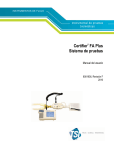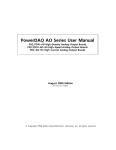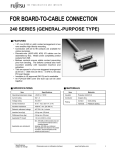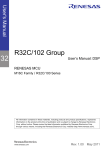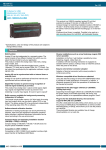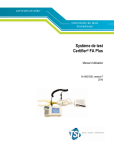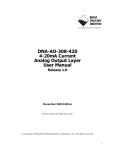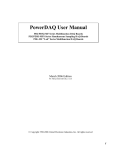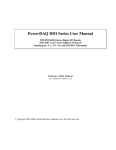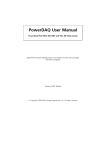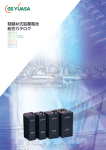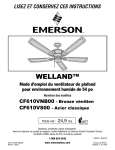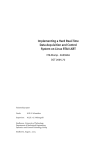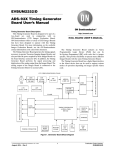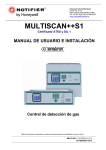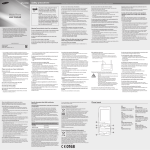Download PD2-AO series - OMEGA Engineering
Transcript
PowerDAQ PD2-AO, PDXI-AO PCI/PXI High-Density 16-bit Analog Output Board User Manual High-Performance Multifunction I/O boards for PCI Bus Computers August 2001 Edition © Copyright 1998-2001 Omega Engineering, Inc. All rights reserved All rights reserved. No part of this publication may be reproduced, stored in a retrieval system, or transmitted, in any form by any means, electronic, mechanical, by photocopying, recording, or otherwise without prior written permission. Third Edition August 2001 Printing Information furnished in this manual is believed to be accurate and reliable. However, no responsibility is assumed for its use, or for any infringements of patents or other rights of third parties that may result from its use. Contacting Omega Engineering ✉ Address: OMEGA Engineering, Inc. One Omega Drive Stamford, Connecticut 06907-0047 U.S.A. ! Support: Telephone: 1-800-622-2378 Fax: 1-800-848-4271 "Internet Access: Support [email protected] Web site http://www.omega.com FTP site ftp://ftp.omega.com Table of Contents Table of Contents How to Use This Manual ......................................................iv Introduction .......................................................................................... iv Who Should Read This Book? .............................................................. iv Organization of This Manual ............................................................... iv Conventions Used in This Manual........................................................ vi Feedback............................................................................................... vi Introduction ..............................................................................2 About the PowerDAQ™ Analog Output series board.......................... 2 Overview ............................................................................................ 2 Features.............................................................................................. 3 AO Applications.....................................................................................4 PowerDAQ AO Models.......................................................................... 5 Getting Started ...................................................................................... 5 Installation and Configuration............................................. 8 Unpacking..............................................................................................8 Hardware ...............................................................................................8 Installing Multiple Boards .................................................................. 9 Software ................................................................................................ 9 Installation.......................................................................................... 9 Base address, DMA, Interrupt settings ............................................10 Diagnostics........................................................................................10 Accessories ...........................................................................................13 Cables................................................................................................13 Screw Terminal Panels ......................................................................15 Complete kits ....................................................................................16 J1 Connector......................................................................................16 J2 Connector (PD2-AO only)............................................................16 J3-J8 Connector(PD2-AO-96 only) .................................................. 17 Architecture ........................................................................... 20 Functional Overview ............................................................................ 20 Analog Output Subsystem (AO) ......................................................21 Digital Output Subsystem ................................................................ 25 Digital Input Subsystem ................................................................... 25 Counter/Timer Subsystem ............................................................... 25 Calibration Subsystem...................................................................... 27 DSP Processor .................................................................................. 27 PCI Bus Interface ............................................................................. 27 Timing and Control .......................................................................... 28 API and Third-Party Software Examples ........................ 32 i Table of Contents API Function calls ................................................................................ 32 API Examples ....................................................................................... 34 Third-party examples........................................................................... 34 Interconnections.................................................................... 36 PD2- AO-8[16][32] Connectors ........................................................... 36 PD2- AO-96 Connectors ..................................................................... 37 PDXI- AO-8[16][32] Connectors ..........................................................38 PD2-AO-8[16][32] J1 Analog Connector .......................................... 39 PD2-AO J2 DIO/Counter/Timers/IRQx Connector..........................40 J1-J2 Connection Example................................................................40 Appendix A: Specifications................................................. 43 PD2-AO specifications:........................................................................ 43 AO subsystem .................................................................................. 43 Digital Input and Output .................................................................44 DSP – based subsystems.................................................................44 Appendix B: Accessories ..................................................... 47 Overview .............................................................................................. 47 Cables: (PD[XI]-CBL-xx)................................................................... 47 Screw Terminal Panels: (PD2-AO-STP-xx).......................................49 Screw Terminal Panels: (PD-STP-3716) ............................................50 OEM Header Distribution Connector............................................... 52 Accessory Board Connections.......................................................... 53 Appendix C: Common Questions and Support .............. 55 Calibration Questions....................................................................... 55 Service and Support............................................................................. 55 Technical Support Form ................................................................... 57 Appendix D: Warranty ........................................................ 58 Overview ..............................................................................................58 Index........................................................................................ 60 ii Table of Contents List of Figures Figure 1: PowerDAQ Control Panel Application ................................... 11 Figure 2: PowerDAQ control panel application showing PD2-AO-32 board installed ..................................................................................12 Figure 3: PD2-AO-STP-32 Wiring Diagram .......................................15 Figure 4: Block Diagram of the PowerDAQ PD2-AO boards........... 20 Figure 5: PowerDAQ PD2-AO-8[16][32] Connectors........................ 36 Figure 6: PowerDAQ™ PD2-AO-96 Connectors .............................. 37 Figure 7: PowerDAQ™ PDXI-AO-8[16][32] Connectors ......................38 Figure 8: Connector pin assignment for the J1 ................................ 39 Figure 9: Connector pin assignment for the J2 ...............................40 Figure 10: Configuring the PD2-AO-STP with PD2-AO-8[16][32] ..........41 Figure 11: Configuring the PD2-AO-STP with PDXI-AO-8[16][32].......... 42 Figure 12: PD2-AO-STP-32 Wiring Diagram ......................................49 Figure 13: PD-STP-3716 Wiring Diagram............................................50 Figure 14: PD-CONN-PCB wiring diagram .............................................. 52 List of Tables Table 1: PowerDAQ™ AO Models ...................................................... 5 Table 2: Сonversion between the PD2-MF(S) and PD2-AO board J1 connector pinout. ............................................................................ 53 Table 3: Dimensions of PowerDAQ™ AO accessory products ..............54 iii How to Use This Manual How to Use This Manual Introduction This manual describes the PowerDAQ™ Analog Output boards. The following boards are supported: PD2-AO-8/16 PD2-AO-16/16 PD2-AO-32/16 PD2-AO-96/16 PDXI-AO-8/16 PDXI-AO-16/16 PDXI-AO-32/16 Two different form-factors are available – 32-bit 33 MHz PCI and 32-bit 33 MHz PDXI. PDXI is a PowerDAQ extension for instrumentation and is a superset of Compact PCI and PXI bus industry-oriented standards. Who Should Read This Book? This manual has been designed to benefit the user of PowerDAQ™ PD2-AO and PDXI-AO boards. To use PowerDAQ™ Analog Output Board, it is assumed that you have basic PC skills, and that you are familiar with Microsoft Windows NT/2000/95/98/Me and/or Linux/QNX operating environments. Organization of This Manual The PowerDAQ™ PD2-AO User Manual is organized as follows: Chapter 1 - Introduction This chapter gives you an overview of PowerDAQ™ Analog Output series board’s features the various models available and what you need to get started. Chapter 2 - Installation and Configuration This chapter explains how to install and configure your PowerDAQ™ Analog Output series board. iv How to Use This Manual Chapter 3 - Architecture This chapter discusses the internal structure and subsystems of your PowerDAQ™ Analog Output series board. Chapter 4 Examples – API and Third-Party Software This chapter explains how to use PowerDAQ™ Analog Output series boards using the PowerDAQ™ API on Visual C++, VB, Delphi, C++ Builder or Third-Party software such as LabVIEW®, TestPoint®, DASYLab®, HP VEE®, etc. Chapter 5 - Interconnections This chapter describes the I/O connections PowerDAQ™ Analog Output series board. to your Appendix A - Specifications This chapter lists the PowerDAQ™ Analog Output series board hardware specifications. Appendix B - Accessories This appendix lists the PowerDAQ™ Analog Output series board accessories products. Appendix C - Common Questions and Support This appendix contains a list of commonly asked questions and their answers relating to usage and special features of your PowerDAQ™ Analog Output series board board. Should you require assistance while installing or using PowerDAQ™ Analog Output series board, support service details are also listed. Appendix D - Warranty This appendix contains a detailed explanation PowerDAQ™ Analog Output series board’s warranty. of Index The Index alphabetically lists topics covered in this manual. v How to Use This Manual Conventions Used in This Manual These are the main conventions used to help you get the most out of this manual: Tips are designed to highlight quick ways to get the TIP job done, or good ideas you might not discover on your own. Note Notes alert you to important information. CAUTION! Caution advises you of precautions to take to avoid injury, data loss, or system crash. Text formatted in bold typeface may also represent type that should be entered verbatim or a command, as in the following example: You can instruct users how to run setup using a command such as setup.exe. Feedback We are interested in any feedback you might have concerning our products and manuals. A Reader Evaluation form is available on the last page of the manual. vi 1 Introduction 1 Chapter 1: Introduction Introduction This chapter describes the PowerDAQ™ PD2-AO boards. basic features of the About the PowerDAQ™ Analog Output series board Thank you for purchasing a PowerDAQ™ Analog Output series board. The board you received is either a PD2-AO PCIbus board or a PDXI-AO CompactPCI bus board. These boards differ in certain hardware respects however the software is the same. The PDXI series Analog Output boards utilize all advantages of the PXI/cPCI form-factor. The associated PowerDAQ™ Software Suite (PD-SDK) has been written specifically for these products. Overview The PowerDAQ analog output boards are configured as 8, 16, 32 or 96 channels. The PDXI versions are available in 8, 16 and 32 channel versions. The PowerDAQ Analog Output board uses 16-bit DACs and allows you to configure the start up states for each channel (200ms maximum delay between system reset and power-on value loading). The onboard DSP/PCI interface allows you to use up to three 24bit counter timers, high-speed IRQ/External Clock lines, eight digital inputs and eight high-drive (-32/64ma) digital outputs. Additionally each board has a special calibration subsystem, which is used to calibrate each analog output channel. 2 Chapter 1: Introduction Features The major features of the PowerDAQ AO boards are: 24-bit 66/100 MHz Motorola 56301 DSP (Digital Signal Processor) “Bus Master Ready” PCI Bus Host PC Interface (PCI 2.1 Compliant) • 8/16/32/96 channel 16-bit +/- 10V DACs • DC-100KHz per D/A throughput • 2MHz/board maximum update rate • 1/2/4/8/16/32/64 Fixed/Unlimited channel list length • Asynchronous/Simultaneous update modes for the all DACs • Eight Digital Inputs • Eight Digital Outputs • Counters/Interrupt/Synchronization inputs • Per-channel calibration • Sense lines for the each DAC (optional), jumperselectable on PDXI models • User-defined Power-Up states for the each DAC (200 ms maximum setup time after the system reset) Default is 0V. • Three 24-bit counter timers (16.5/25MHz maximum) • On-board 2K FIFO (located in the DSP memory) • 32Ksamples FIFO upgrade option • Software: PowerDAQ for Windows95/98/Me/NT/2000/XP/Linux/QNX Visual C++, VB, Delphi, C++ Builder, Kylix Drivers for: LabVIEW® HP VEE® LabWindows/CVI® TestPoint® DASYLab® DiaDem® MATLAB DAQ Toolbox Note For the full list of specifications, see Appendix A: Specifications. 3 Chapter 1: Introduction AO Applications PowerDAQ Analog Output series boards provide a wide range of powerful features that cover a wide range of applications. The most common applications are: • • • • • • Process Control ATE Closed-loop Servo-Control Motor Control Individual DAC voltage output Telecommunications equipment control (micro mirrors) The Digital Input and Digital Output Subsystems applications: • • • • Electro-mechanical relay control applications Solid-state relay applications Alarm System sensors Digital motion control The Counter-Timer Subsystem applications: • • • PWM modulator Frequency counter Pulse generator Note The easiest way to expand the possibilities of the PD2AO/PDXI-AO board is to use the PD2-MF/S or PDXIU-MF/S multifunction boards series in the same PC. 4 Chapter 1: Introduction PowerDAQ AO Models PowerDAQ PD2-AO/PDXI-AO model numbers are derived as follows: PD2-[Type Of Board]-[Channels]-[Speed]/[Resolution][Gain] PDXI-[Type Of Board]-[Channels]-[Speed]/[Resolution][Gain] The types of boards are: MF Multifunction AO Analog Output DIO Digital Input /Output CTM Counter Timer Models AO Features PD2-AO-8/16 PCI bus Eight 16-bit Analog Output Channels PD2-AO-16/16 PCI bus Sixteen 16-bit Analog Output Channels PD2-AO-32/16 PCI bus Thirty-two 16-bit Analog Output Channels PD2-AO-96/16 PCI bus Ninety-six 16-bit Analog Output Channels PDXI-AO-8/16 PXI/CPCI bus Eight 16-bit Analog Output Channels PDXI-AO-16/16 PXI/CPCI bus Sixteen 16-bit Analog Output Channels PDXI-AO-32/16 PXI/CPCI bus Thirty-two 16-bit Analog Output Channels Table 1: PowerDAQ™ AO Models All PowerDAQ™ AO boards have the following additional features: Digital Input Eight static digital inputs Digital Output Eight static digital outputs Clock/Interrupt Lines Counter Timers Three 24-bit (33/50MHz Internal/16.5/25 MHz External) Getting Started To get your PowerDAQ AO board up and running, ensure that you have the following: A computer with PCI slots (for PD2-AO models) or PXI/CPCI slots (for PDXI-AO models) and the BIOS compliant to PCI Specifications 2.1 or greater. See Appendix C: Common Questions and Support. PowerDAQ™ PD2-AO PCI/PDXI-AO board with user manual. 5 Chapter 1: Introduction Latest PowerDAQ™ Software Suite CD (PD-SDK) Software. This can be downloaded from www.PowerDAQ.com/download Minimum 16MB RAM for Windows9x and 32MB for Windows NT/98/Me and 64MB for Windows 2000 6 2 Installation and Configuration 7 Chapter 2: Installation and Configuration Installation and Configuration This chapter describes the hardware and software installation and configuration of the PowerDAQ AO board. Unpacking Your PowerDAQ™ AO board is wrapped in an anti-static bag to protect against electrostatic charges that might damage the board. To avoid damage, proceed as follows: Ground yourself with a grounded wrist strap or grounded source. Discharge the static electricity by taking the board in the antistatic bag and touching the metal part of your PC. Remove the board from the antistatic bag. We suggest you save the bag. Inspect the board for any damage. If any damage is found, notify your distributor to return the board to the manufacturer. See Appendix C: Common Questions and Support. Note The PowerDAQ AO boards contain sensitive electronic components. Please make sure the proper grounding and electrostatic conditions are used. Hardware You can install your PowerDAQ PD2-AO board in any PCI slot. PDXI-AO boards should be installed into the Compact PCI/PXI/PDXI chassis only. We recommend you use the first available slot and complete the following instructions: PCI board installation: 1. Turn off your PC. Remove the cover and make sure you have clear access to the PCI slots. Connect all desired cables to the PD2-AO board. Insert the PowerDAQ PD2-AO board into a PCI slot. (If the PCI slots have not been used for a long time, insert the PowerDAQ PD2-AO board, then remove it and clean 8 Chapter 2: Installation and Configuration the edge connector with alcohol. After this has been done, replace the bard back into the slot.) Screw the bracket and replace the cover. Turn the PC on. PDXI board installation: 1. Turn off your PC. 2. Remove the slot cover. 3. Insert the PowerDAQ PDXI-AO board into a slot. 4. Screw the bracket. 5. Turn the PC on. The PowerDAQ AO board is now installed. All board configurations are controlled via software using the PDSUITE. Note For the Windows 95/98/Me/2000/XP platforms, you should install PowerDAQ Software Suite prior the board installation. Installing Multiple Boards You can install multiple PowerDAQ AO boards in one PC. You are limited to the number of PCI/PDXI slots in your PC. Software PowerDAQ Software Suite CD contains drivers and software (example code with source code) for Windows, Linux and QNX (optional). You can always download the latest software suite from www.PowerDAQ.com/download. Installation From the CD, run the SETUP.exe program. The setup program will take you through the installation process. If you downloaded the PowerDAQ software from the web you just need to run the file downloaded and follow the setup instructions. 9 Chapter 2: Installation and Configuration As the installation process modifies your Windows registry, you must only install or uninstall the software using the appropriate programs. Note Never delete the PowerDAQ software from you PC directly. Always use Uninstall program from PowerDAQ folder or Control Panel/Add-Remove Programs applet. Note Once the installation is complete, the PC must be rebooted for proper operation. Note Windows NT/2000/XP users must be logged in as an administrator or have equivalent access. Base address, DMA, Interrupt settings The PowerDAQ AO boards are configured automatically by the computer BIOS on power up. Usually you do not have to set any base address, DMA channels or interrupt levels. The PowerDAQ driver is designed to share interrupts over PCI devices but very rarely will the BIOS assign same interrupt to mass-storage devices such as a SCSI controller or video card and a PowerDAQ board. In this case it could be significant latency between the time when board fires an interrupt and the time the PowerDAQ driver actually receives it. In this case we recommend changing your BIOS settings and assigning a dedicated interrupt for the PowerDAQ board. Please refer to your motherboard/computer manual for the BIOS settings change procedure. Diagnostics In order to confirm board operation, install the PowerDAQ Suite. This automatically installs the PowerDAQ application control panel diagnostic program that will display all available PowerDAQ boards in your system. 10 Chapter 2: Installation and Configuration To access the PowerDAQ control panel, select START > Settings > Control Panel and the PowerDAQ icon will be displayed. Figure 1: PowerDAQ Control Panel Application An alternative test is to use the SimpleTest program installed by the Software Suite. Attached a oscilloscope of multimeter to the outputs of the AO board. Run the SimpleTest.exe program by selecting START > Programs > PowerDAQ > Delphi Acquisition Demo. This program shows all information about the board(s) installed and allows you to test all subsystems available on the board selected for the test. 11 Chapter 2: Installation and Configuration Figure 2: PowerDAQ control panel application showing PD2-AO32 board installed Please refer to the PowerDAQ Software manual for a complete set of ready to run example programs and the detailed API for programming of the PowerDAQ AO boards. All PowerDAQ AO manuals are supplied in electronic Adobe Acrobat PDF format. If you require the PDF reader, this can be downloaded from the Internet from www.adobe.com 12 Chapter 2: Installation and Configuration Accessories PowerDAQ AO boards have an extensive range of optional accessories: Cables (3ft, 6ft or 9ft) Screw terminal panels Complete kits J1 high-density analog cable (PD2-AO-8[16][32] only) J2 PD-CBL-37 DIO connection kit (PD2-AO only) J3-J8 IDC40 to DB37 flat/twisted pair ribbon cable (PD2AO-96 only) J1 to J1/J2 splitter analog/digital cable Cables Digital cable (PD2-AO boards only) PD-CBL-37: The J2 connector uses a 37-way ribbon connector set. It comprises of a 13” internal ribbon cable, which connects from the PowerDAQ AO board J2 internal digital connector (DIO /Counters/IRQs) to a 37-way D-SUB bracket. A 1-meter ribbon cable then connects from the bracket to the PD2-AOSTP accessory panels. Analog cable (PD2-AO-8[16][32] boards only) PD-CBL-96: The J1 connector uses a 96-way shielded round 1-meter cable with a metal connector on either end. It connects to: PD2-AO-STP16or 32, PD-BNC-16 or 64 accessory panels. 13 Chapter 2: Installation and Configuration Analog cable (PD2-AO-96 boards only) PD-CBL-4037TP: The J3-J8 connector uses a 36-way flat or twisted pair ribbon cable (DB37 to IDC40) to bring out the analog output signals. It connects to: PD-STP-3716, so one PD2-AO96/16 board requires a set of six cables and terminals for all ninety-six channels. Note The PowerDAQ PD2-AO-8/16/32 boards require a PDCBL-96 and the PD2-AO-96 requires up to 6 PD-CBL-4037TP. If digital IO/CTM is going to be used, an optional PD-CBL-37 cable is required. Custom cables are available. Please contact the factory for more details. Splitter analog/digital cable (PDXI-AO boards only) PDXI-CBL-AO: The J1 connector uses a split round shielded cable, which brings out the analog signals to a 96way “pin-less” Fujitsu connector and the digital I/O signals to 37-way DB-37 connectors. It connects to: PD2-AO-STP-xx, PD-BNC-xx accessory panels. 14 Chapter 2: Installation and Configuration Screw Terminal Panels The PD2-AO-STP-16/32 is a 16/32-channel screw terminal panel, which also includes connections for the counter timers, high speed interrupt/synchronization lines and DIO ports. Using the jumpers, each sense line can be connected to the appropriate output directly on the screw terminal. Note For the all PDXI-AO boards, the sense to force line jumpers are located directly on the board. All jumpers should be removed from the PD2-AO-STP panel in this case. PD-AO-STP-32 Cable PD-CBL-96 PD-AO-STP-32 Because of compatible pin-outs, the PD-BNC-xx terminals can be used with PD2-AO-8[16][32] boards. Custom terminal panels are available. Please contact the factory for more details. PDXI-CBL-AO PD2-AO Board Cable PD-CBL-37 PDXI-AO board Figure 3: PD2-AO-STP-32 Wiring Diagram 15 Chapter 2: Installation and Configuration The PD-STP-3716 is a low cost 16-channel screw terminal panel, which can be used with the PD2-AO-96/16 or PD2AO-8/16. This terminal contains analog signals only. For the digital signals, you will need the PD-STP-DIO. Complete kits We have included the PD-CBL-96 and the PD2-AO-STP-32 into a complete kit for the PD2-AO-8[16][32] boards. The product is available by ordering PN PD2-AO-STP-16KIT or 32. Also complete kits are available for the PDXI-AO boards. These products are available by ordering PN PDXI-AO-STP16KIT or –32KIT. J1 Connector If you wish to develop you own custom cable, you can purchase the connector and metal cover from your distributor or the factory. The part number is PD-CONN. The manufacturer is: Fujitsu Takamisawa America, Inc. Telephone: 408-745-4990 Fax: 408-745-4995 The manufacturers’ part number for the connector is FCN-230C096-C/E and the metal cover FCN-247J096G/E. Custom terminal panels are available. Please contact your distributor or the factory. J2 Connector (PD2-AO only) J2 connector is a 36-way boxed IDC header. The manufacturer is Tomas & Betts (www.tnb.com) . The manufacturers’ part number for the connector is 6093627. 16 Chapter 2: Installation and Configuration J3-J8 Connector(PD2-AO-96 only) J3-J8 connectors are 40-way boxed IDC headers. The manufacturer is 3M (http://www.mmm.com/esm/). The manufacturers’ part number for the connector is 25406002UB. 17 Chapter 2: Installation and Configuration 18 3 Architecture 19 Chapter 3: Architecture Architecture This chapter describes the functional operation of the PowerDAQ AO boards. DAC31 AOut Control User Counter Timer 3x24-bit AOUT31 DAC30 AOUT30 SENSE DAC29 3 Digital Input DAC28 (8) Buffer Latch Interrupt DOut Control Address Analog Output Amplifiers DAC3 Local Data Bus Digital Output (Driver) (8) Bootstrap ROM User Clock User Clock 12k Program RAM 12k Data RAM Motorola 66MHz DSP 56301 Bus Master PCI Interface IRQB IRQC Configuration & Calibration EEPROM Data Voltage Reference Control AOut Calibration DACs IRQA Address DAC0 6 Channel DMA DAC1 AOUT0 AOut Clock AOUT0 SENSE ESSI DAC2 AOut FIFO External Analog Output Connector (J1) AOUT1 3 Out DIn Control AOUT30 AOUT1 SENSE Clock Internal Digital I/O Connector J2 AOUT31 SENSE 32 Bit PCI Bus Figure 4: Block Diagram of the PowerDAQ PD2-AO boards Functional Overview Although there are some functional differences between the PD2-AO and PDXI-AO boards they all utilize the same PowerDAQ software, which significantly simplifies the software development process. 20 Chapter 3: Architecture Analog Output Subsystem (AO) The PowerDAQ II analog output boards are configured as 8, 16, 32 or 96 sixteen-bit output channels. On the PD2-AO8[16][32] each channel has an optional sense line to provide 16-bit accuracy at rated output current. The PDXI-AO board allows the use of sense lines on the first sixteen channels by installing on-board jumpers. The PD2-AO-96 does not provide the sense line option. Note The default sense line option is not available on PD2AO boards because of noise considerations – high currents going through the cable induce more noise) and sense lines carry the same signal as corresponding output lines inside the cable. Please take this into consideration when configuring the sense lines (if required). The AO subsystem also includes input modes, channel queue, trigger and clocking control. Interrupt (event) generation: You can use events to provide gap-free updates of the analog outputs. There are three update modes for the analog subsystem • Single update • Event (interrupt) – based waveform mode • Continuous pulled-IO waveform mode and autoregeneration waveform mode. The user can define the power-on value of each (the default start-up value is set to zero). The utility application “Start-Up Configuration (StartUpState.exe) is installed by the SDK can be modify the start-up states. channel included Wizard” used to Note The Power-On state will be loaded into the DACs with 200 ms maximum delay after the system reset. The calibration values will be loaded only when PowerDAQ driver is loaded and up to +/-30 mV offset is possible on the outputs during the system boot process. 21 Chapter 3: Architecture Note The quad output DACs has current limitations. Only one output of each quad can be continuously shorted to ground. Two, three and even four channels shorted to ground MUST NOT exceed five seconds. Analog Output Mode Single Update The PowerDAQ AO boards operate with either a singleupdate or streaming (waveform) output configuration. Single-update mode allows direct write access to any of the 16-bit DACs of the PowerDAQ AO board. The update frequency is at least 1kHz for the single update mode and can be as high as 15KHz in real-time operating environments. The single update speed is dependent on your PC system speed. Note There is a special sub-mode of the single update mode when all or selected DAC’s outputs are updated simultaneously. Event-based Waveform Event-based waveform mode allows continuous waveform generation and is not limited by the amount of data. Each time the DSP based FIFO is ½ full an interrupt is fired to request additional data to be sent to the board. The PowerDAQ advanced buffering mechanism hides those interrupts from the user and allows you to work with big output arrays logically divided by frames. The end of each frame can generate an event, which will request more data from the application. Complete information on the PowerDAQ advanced circular buffer (ACB) can be found at www.POwerDAQ.com Note If the on-board FIFO is empty or the last value is outputted, the board will continue outputting the last DC value. 22 Chapter 3: Architecture Auto-regeneration Waveform (circular waveform) Auto-regeneration waveform mode can be used to create fixed length waveforms without any host intervention of user software after the subsystem has initialized. An application writes data to the buffer of the PowerDAQ AO board and each time the end of buffer is reached, it starts to resend the same buffer again. Note, that 2048 samples can fit into the on-board DSP memory and auto regeneration of up to 2048 samples will not require any intervention of the host PC. Channel List There are two ways do define a Channel List for PowerDAQ AO board. First, when the output data channel number are combined together to provide output channel selection. In this situation, the lower 16 are data, the following upper 8, the channel number special flags (see the picture below). the and the bits and This mode supports update rates up to 455KS/sec 31 Not used 23 Flags, Ch# 15 0 16-bit output data Bits 16-20 are used to define the output channel number on a PD2/PDXI-AO-8[16][32] board. Bit 21, when set is used as a Write and Hold Flag – this is used to write data to the DAC WITHOUT updating it on a PD2/PDXI-AO-8[16][32] board. Bit 22, when set is used as an Update All Flag – all DAC’s will be updated by the previously written data on a PD2/PDXI-AO-8[16][32] board. PD2-AO-96 board only: Bits 16-22 are used to define the output channel number on PD2/PDXI-AO-8[16][32] boards. 23 Chapter 3: Architecture Bits 21,22,23 when all set together are used as a Write and Hold Flag – written to DAC’s data with this bit set will not update output. Bits 23, when set is used as Update All Flag – all DAC’s will be update by previously written data. This is the default configuration, which provides an unlimited channel list length. Another way to define the channel list is a series of continuous channel numbers(1/2/4/8/16/32/64), up to the number of ports available on the AO board, starting at any channel. For example, the PD2-AO-32, channels 0 through 15 can be specified as a channel list of channels to be updated in Event-based Waveform Mode and the remaining channels can be used in Single Update Mode. This mode is called DMA-based update mode and supports output rates up to 1.6 MS/sec. Note There is a dedicated function in the PowerDAQ API called _PdAO32SetUpdateChannel which can be used to specify the update channel number. Any write to this channel will force the update of all DAC’s. 24 Chapter 3: Architecture Digital Output Subsystem There are eight static digital outputs on the PowerDAQ analog output board. They are TTL/CMOS output level compatible, 2000V ESD protected. Due to the static nature of the outputs they can be updated at any time without any limitations. Digital outputs provide high current compatibility (-32/64 ma), which support drive relays or these lines can be used for control applications. Digital Input Subsystem There are eight static digital inputs on the PowerDAQ analog output board. They are TTL/CMOS input level compatible, 2000V ESD protected. Due to the static nature of the inputs they can be read at any time without any limitations. Counter/Timer Subsystem Depending on your PowerDAQ AO operation mode, the board can support up to the three DSP based 24-bit counter/timers with a maximum count rate up to 33 MHz for 66MHz DSP and 50MHz for 100MHz DSP (PDXI-AO only) for an internal base clock and 16.5 MHz/25MHz for the external clock. The minimum count rate is 0.001 Hz for the internal clock and no low limits for the external clock. Note For all waveform modes, only Timer0 and Timer1 are available for use. Programming of the counter/timer subsystem of the PD2AO board requires a minimal understanding of the Triple Timer Module of the Motorola 56301 DSP. For this information please refer to the Motorola DSP 56301 User Manual (Motorola P/N DSP56301UM/AD). 25 Chapter 3: Architecture Each timer can be used for internal or external clocking and can interrupt the on-board DSP after a specified number of events (clocks) or signal an external device after counting internal events. Each timer can also be used to trigger DMA transfers after a specified number of events (clocks) have occurred. Each timer connects to the external world through one bi-directional pin TIO that is 7kV ESD protected. When TIO is configured as input the timer functions as an external event counter or can measure external pulse width/signal period. When TIO is used as output, it functions as a timer, watchdog or Pulse Width Modulator. Some common timer/counter/output microprocessors require are: Real time clock, Event counter Digital one-shot Programmable rate generator Square wave generator Binary rate multiplier Complex digital wave form generator Complex motor control functions that Note Each counter is a 24-bit count-up counter After power-up, the count value and output of all counters are set to zero Each counter must be programmed before it can be used Unused counters need not to be programmed Use the PowerDAQ API to program counters. Each counter is fully independent of the others. Only prescaler, when used, is a common part of the counter-timer subsystem. Each counter may operate in a different mode 26 Chapter 3: Architecture Calibration Subsystem The calibration subsystem is used to calibrate each analog output zero offset (with 150-microvolt accuracy) and output range (PD2-AO only). The calibration data is stored in the on-board EEPROM. Additionally a PowerDAQ AO board provides an application for the user to configure the startup output value of the any DAC. This value will be loaded immediately after a system reset or power-on with 200 ms maximum latency. DSP Processor All PowerDAQ AO boards are based on the Motorola 56301 DSP. This is a 24-bit 66/100 MHz processor with an integrated PCI interface. The PCI interface implements the PCI Local Bus Specifications so the board is fully autoconfigured (base address, interrupt). When the PowerDAQ software is loaded, the PowerDAQ AO firmware is downloaded to the DSP via the PCI bus. This firmware contains all the code necessary to communicate with the board subsystems and the host PC driver. Note The drivers from the PowerDAQ web site always contain the latest versions of the DSP firmware. Note Custom programming of the DSP is not available with the standard PowerDAQ AO product. However, should you require DSP processing, please contact the factory. PCI Bus Interface The PowerDAQ AO boards communicate via the PCI bus. The PCI bus interface is embedded in the Motorola 56301 DSP. On power up, the host PC automatically configures the boards base address and interrupt resources. 27 Chapter 3: Architecture Timing and Control The PowerDAQ AO clocking and triggering features are extensive and can be configured in various different ways. Analog Output Clocking Clocking comprises of two input signals: 1. 2. Clock In – used to clock analog output channels in channel list. Trigger In – used to start/stop acquisition . You must load the channel list prior to starting this operation. Clocking can be controlled by: Software Strobe Internal Clock (DSP) External Clock Universal External Interrupt/Clock/Synchronization Inputs Note You can only use these lines for Analog Output Clocking OR Triggering Triggering is configured as follows: Use the IRQB pin to asynchronously update all DACs. Use the IRQC pin to supply your external trigger source. Trigger modes: Start trigger (acquisition starts on rising edge of the trigger signal) Stop trigger (acquisition stops on rising edge of the trigger signal) Trigger lines should be pulled-down to ground via 4.7Kohm resistors. 28 Chapter 3: Architecture Synchronizing two or more boards Note Using the PowerDAQ AO control panel application, please ensure the software driver recognizes the two or more PowerDAQ AO boards. No custom synchronization cables are required – all connections can be made directly on the screw terminal. PDXI-AO boards provides a special configuration program PDXICFG.EXE that allows synchronize boards via the PXI bus extension. This feature is not available in standard Compact PCI chassis. If internal connection between multiple boards is required, the following connections should be made (PD2-AO boards only): The PowerDAQ PD2-AO J2 internal connector has a TMR2 Clock I/O pin. You can connect this pin to the TMR2 pin of the next board you wish to synchronize acquisition. It is preferable to use a 100-200 Ohm series resistor for the clock connection. For a custom cable contact the factory. 29 Chapter 3: Architecture 30 4 API and Third-Party Software Examples 31 Chapter 4: API and Third-Party Software API and Third-Party Software Examples The PowerDAQ Software Suite API and third party software drivers support all PowerDAQ AO board features. This chapter provides an overview on how to use the API calls and examples using third-party software. API Function calls Please refer to PowerDAQ SDK and programmer manual for the details about Analog Output board programming. Generally Analog Output subsystem works in the same way as all other paced subsystems. The following command sequence should be used to program the PowerDAQ AO board in a low-level language such as C/C++/VB/Delphi: 32 • Open Driver. This allows you to check that the driver is installed properly and started and also gets a number and parameters of the PowerDAQ boards installed in the system. • Open Adapter. After the adapter is opened the PowerDAQ SDK return a special handle that should be used for all calls referring to a specific PowerDAQ board installed. This call locks the specific PowerDAQ board by the specific application. • Open Subsystem. This call grants access to one of the available PowerDAQ board subsystems. The following subsystems can be accessed on a PowerDAQ Analog Output board: Analog Output, Digital Input, Digital Output, DSP Counter and Calibration. • Work with subsystem. There are two different ways to use a subsystem – in synchronous and asynchronous mode. Chapter 4: API and Third-Party Software • In Synchronous Mode (known as Single Update on the AO subsystem) there is a set of calls available which gives direct and immediate access to the DACs (DIO ports and DSP Timers). Timed access can be made using the operating system based timing loops. • In Asynchronous Mode (which has two sub-modes on PowerDAQ AO boards – event-based and regenerate mode) , a dedicated acquisition buffer is allocated in host PC memory. This buffer is divided by the number of logical blocks called frames, usually between 4 and 16 frames should be allocated. The following steps should be considered when Asynchronous acquisition mode is used: # User application uses API calls to allocate the acquisition buffer and fill it with initial data for all output subsystems. # Subsystem configuration word should be assembled using the API constants provided. # The user application should define a set of events from the board. A typical set of events include data availability events and error events # Start of asynchronous operation # WaitForSingleObject operating system function call or an equivalent should be used to check for events from the board. It is preferable to put this call into a separate thread. After an event, the application should re-initialize it and process the data. # Terminate asynchronous operation # Auto-regenerate mode user application can allocate one or more frames in the buffer, fill it with data and start acquisition. The PowerDAQ driver will control event handling and supply more data into the on-board FIFO as requested. Note, that frame size cannot exceed 64Mbytes. The size of the buffer itself is limited by the amount of Physical memory installed on your PC. 33 Chapter 4: API and Third-Party Software • Close subsystem. When the application closes the subsystem it’s frees-up resources. • Close adapter. After the adapter is closed it is accessible from other applications. • Close driver. API Examples The PowerDAQ Software Suite contains a complete set of selfdocumented examples dedicated to PowerDAQ AO boards programming. The best way to write your own program is to use a ready-to-run example and modifiy it as required by your application. The examples are available in the following languages: C/C++/Delphi/VisualBASIC: • Single Update Example (Separate example available for the PD2-AO-96/16 board) • Buffered output Example (Event-based) Please refer to the example sources for extensive programming details. All examples are located in <Program Files Dir>\PowerDAQ\SDK\Examples\<Language>\<Example> Third-party examples All third-party drivers, supplied by OMEGA include a set of examples, which support all of the PowerDAQ Analog Output board features. They are usually installed during the SDK installation process into the folders defined by third-party software vendors. Please refer to the readme file of the SDK version to find an exact location of the examples you need. 34 5 Interconnections 35 Chapter 5: Interconnections Interconnections PD2- AO-8[16][32] Connectors PowerDAQ(tm) PD-AO-8[16][32] board J2 Connector J1 Connector The PowerDAQ PD2-AO-8[16][32] boards have two connectors and one header: 96-contact high-density Fujitsu header – analog output connector (J1) 36-way boxed IDC header (DIO/Timer and IRQ lines) Figure 5: PowerDAQ PD2-AO-8[16][32] Connectors Note For manufacturers part numbers, see Appendix A: Specifications. 36 Chapter 5: Interconnections PD2- AO-96 Connectors The PowerDAQ PD2-AO-96 boards have seven headers on it: 40-way boxed IDC header – analog output connectors (J3J8) 36-way boxed IDC header (DIO/Timer and IRQ lines) J2 Connector PowerDAQ(tm) PD-AO-96 board J7 Connector J8 Connector J5 Connector J6 Connector J3 Connector J4 Connector Connectors from all cables are going through the PCI bracket. Following connector layout is defined : J2- DIO/Timers J3 - AOut 0..15, J4 - AOut 16..31, J5 - AOut 32..47, J6 - AOut 48..63, J7 - AOut 64..79, J3 - AOut 80-..95 Figure 6: PowerDAQ™ PD2-AO-96 Connectors Note For manufacturers part numbers, see Appendix A: Specifications. 37 Chapter 5: Interconnections PDXI- AO-8[16][32] Connectors The PowerDAQ PD2-AO-8[16][32] boards have only one connector: 96-contact high-density Fujitsu header – analog output and DIO/Timers connector (J1) PowerDAQ™ PDXI-AO-8[16][32] J1 Channels 0..15 sense line jumpers. Install 1-2 and 3-4 jumpers to short sense line with corresponding output on the board. SNSx terminals are grounds in this case. Install 2-3 jumpers to keep sense line in the cable. In this case screw terminal jumpers should be installed. Rows : A-AOut3, B-AOut2, C-AOut1, D-AOut0, E-AOut7, F-AOut6, G-AOut5, H-AOut4, I-AOut11, J-AOut10, K-AOut9, L-AOut8, M-AOut15, N-AOut14, O-AOut13, P-AOut12 Factory-installed jumpers (PDXI-AO-8[16] boards only). Connects outputs 16..31 to the analog ground to provide more grounds in the cable Figure 7: PowerDAQ™ PDXI-AO-8[16][32] Connectors Note For manufacturers part numbers, see Appendix A: Specifications. 38 Chapter 5: Interconnections PD2-AO-8[16][32] J1 Analog Connector AGND AGND AGND AGND NC AGND AOUT31 AOUT29 AOUT27 AOUT25 AGND AOUT22 AOUT20 AOUT18 AOUT17 AOUT15 AOUT13 AGND AOUT10 AOUT8 AOUT6 AOUT5 AOUT3 AOUT1 AGND AGND AGND AGND AGND AGND AOUT30 SENSE AOUT28 SENSE AOUT27 SENSE AOUT25 SENSE AOUT23 SENSE AGND AOUT20 SENSE AOUT18 SENSE AOUT16 SENSE AGND AOUT13 SENSE AOUT11 SENSE AOUT9 SENSE AOUT8 SENSE AOUT6 SENSE AOUT4 SENSE AGND AOUT1 SENSE 49 50 51 52 53 54 55 56 57 10 58 11 59 12 60 13 61 62 15 63 16 64 17 65 18 66 19 67 20 68 21 69 22 70 23 71 24 72 25 73 26 74 27 75 28 76 29 77 30 78 31 79 32 80 33 81 34 82 35 83 36 84 37 85 38 86 39 87 40 88 41 89 42 90 43 91 44 92 45 93 46 94 47 95 48 96 1 2 3 4 5 6 7 8 AGND AGND AGND AGND AGND AGND AOUT30 AOUT28 AOUT26 AOUT24 AOUT23 AOUT21 AOUT19 AGND AOUT16 AOUT14 AOUT12 AOUT11 AOUT9 AOUT7 AGND AOUT4 AOUT2 AOUT0 AGND AGND AGND AGND AGND AOUT31 SENSE AOUT29 SENSE AGND AOUT26 SENSE AOUT24 SENSE AOUT22 SENSE AOUT21 SENSE AOUT19 SENSE AOUT17 SENSE AOUT15 SENSE AOUT14 SENSE AOUT12 SENSE AOUT10 SENSE AGND AOUT7 SENSE AOUT5 SENSE AOUT3 SENSE AOUT2 SENSE AOUT0 SENSE Figure 8: Connector pin assignment for the J1 39 Chapter 5: Interconnections The compatible pin out was used for the PD2-AO-8[16][32] and PD2MF(S) J1 connector to provide the ability to use common accessories. For the details see conversion table in Appendix B. Note, that on PD2AO-8[16] AOUT16..31 and AOUT16..31 SENSE are connected to the ground. PD2-AO Connector J2 DIO/Counter/Timers/IRQx DGND TMR0 DGND DGND TMR1 DIN0 DIN1 DIN2 DIN3 DIN4 DIN5 DIN6 DIN7 IRQA IRQB IRQC DGND DGND 1 2 3 4 5 6 7 8 9 10 11 12 13 14 15 16 17 18 19 20 21 22 23 24 25 26 27 28 29 30 31 32 33 34 35 36 DGND TMR2 DGND DGND +5VPJ2 DGND DOUT0 DOUT1 DOUT2 DOUT3 DOUT4 DOUT5 DOUT6 DOUT7 DGND DGND DGND DGND Figure 9: Connector pin assignment for the J2 J1-J2 Connection Example The example below shows how to connect PD2-AO board to the PD2-AO-STP screw terminal. Note For the PD2-AO-8[16] board lines OUT16-OUT31 and OUT16S-OUT32S are tied to the analog ground. 40 Chapter 5: Interconnections PowerDAQ II Analog Output Board (8/16/32 Channels) PD-CBL-37 Local /Remote Sense jumpers IRQx and TMRx termination jumpers Channels 16-31 PD-CBL-96 PD-AO-STP-32 Screw Terminal Channels 0-15 and digital lines Jumpers JP1-JP32 defines the sense configuration for the channels 0..31 respectively. When shunts installed at locations B-C the channel is configured to remote sense and SNSx terminal used to connect this line to the remote equipment. If shunts are installed at A-B and C-D locations the channel is configured to local sense (at screw terminal) and SNSx terminal for the selected channel connected to the AGND To/from Digital sensors AOUTx SNSx AOUTx – channel x output SNSx – channel x sense line or AGND (see jumpers JP1JP32 settings) To the servomotors, etc. Figure 10: Configuring the PD2-AO-STP with PD2-AO-8[16][32] 41 Chapter 5: Interconnections PDXI Analog Output Board (8/16/32 Channels) J6 J8 Local /Remote Sense jumpers IRQx and TMRx termination jumpers Channels 16-31 PDXI-CBL-AO PD-AO-STP-32Screw Terminal Sense-to-Out jumpers. JP0.15 jumpers should be installed only if jumpers on J6 jumper pattern on PDXI-AO board in 2-3 positions. JP16..31 should NEVER be installed. See PD2-AO-8[16][32] connection for the details. Channels 0-15 and digital lines To/from Digital sensors AOUTx SNSx AOUTx – channel x output SNSx – channel x sense line or AGND (see jumpers JP1JP32 settings) To the servomotors, etc. Figure 11: Configuring the PD2-AO-STP with PDXI-AO-8[16][32] 42 Appendix A: Specifications Appendix A: Specifications PD2-AO specifications: The following conditions apply: TA = 0°C to +85°C AO subsystem Parameter Number of channels Resolution Update rate Buffer Size Type of D/A Accuracy DNL Monotonicity Over Temperature Gain Error Range Output Coupling Output Impedance Current Drive Capacitive Loads Settling time Slew Rate Gain Bandwidth Noise Output protection Power-on state, default, user programmable Gain drift Value 8,16,32 or 96 (PD2-AO only) 16 bits 100 KS/s channel, up to 1600 KS/s aggregate throughput in DMA mode, 455 KS/s in unlimited channel list mode. 2k samples (upgradeable to 32 KSamples on PDXIAO models) Double-buffered +/- 3 LSB max +/- 3 LSB max 15 bits 0.02% (PDXI-AO), 0.05% (PD2-AO) +/- 10V fixed, 0..10V factory-installed available for PD2-AO-96/16 board DC 0.15 Ohm max +/-5mA (PDXI-AO,PD2-AO-96) +/-20mA(PD2-AO-8[16][32]) 180 pF min 10uS to 0.003% 10V/uS 1 MHz 2LSB RMS, 0-10000Hz Short to ground, +/- 15 Volts 0.0000V +/-25mV (PD2-AO-8[16][32] 0.0000V +/-5mV (PD2-AO-96, PDXI-AO) 25ppm/deg C option 43 Appendix A: Specifications Note Due to the quad DACs, the current is limited. Only one output of each may be continuously shorted to ground. The current is limited to 40 ma for PD2-AO-8[16][32] boards and 20 ma for all other models. Digital Input and Output Parameter Number of channels Compatibility Power-on state Input termination Output High Level Output Low Level Input Low Voltage Input High Voltage Input current Value 8 inputs and 8 outputs CMOS/TTL, 2KV ESD protected Logic Zero 4.7Kohm pull-up to 5V 3.0V min @ -32 mA, 3.4V min @ -16 mA, 4.2V min @ -2 mA 0.55V max @ 64 mA 0.0 - 0.8 V 2.0 - 5.0 V 1uA DSP – based subsystems There are two DSP-based subsystems available on the PowerDAQ DIO boards: • Counter/timers • High-speed interrupts DC ELECTRICAL CHARACTERISTICS BASED SUBSYSTEMS FOR Counter/timers Parameter Number of channels Resolution Maximum frequency Minimum frequency Minimum Pulse Width 44 Value 3 24 bits 16.5/25MHz for the external, 33/50 MHz for the internal clock (see notes) DC for input, 0.001Hz for output 20 nS DSP- Appendix A: Specifications Output High Level Output Low Level Input Low Voltage Input High Voltage Input current • • • • • • • 2.0V min @ -4 mA 0.5V max @ 4 mA 0.0 - 0.8 V 2.0 - 5.0 V 1uA External Event Counter Input Width Measurement Input Period Measurement Event Capture Pulse Width Modulation (PWM) Watchdog Pulse Watchdog Toggle Note The external clock frequency should be less than the internal operating frequency divided by 4 (I.e. 16.33/25.00 MHz for 66/100 MHz DSP). The standard PowerDAQ boards ships with a 66 MHz DSP. COUNTER/TIMER SPECIFICATIONS: NoteThe maximum timer frequency is 16.33 MHz for external clock and 33 MHz for internal clock (66 MHz DSP core). TIO assumes timer I/O pin, CLKOUT – DSP clock. The minimum pulse width is 20 ns for an external clock/event. The following conditions apply: TA = 0°C to +100°C; C load = 50pF + 2 TTL loads 45 Appendix A: Specifications CONNECTORS SPECIFICATIONS Connector J1 (PD2-AO-8[16][32], PDXI-AO) J2 (PD2-AO) J3-J8 (PD2-AO-96) Description/Manufacturer/P/N Fujitsu Takamisawa America, Inc. 408-745-4990 Fax: 408-745-4995. Connector p/n FCN-230C096-C/E and the metal cover p/n FCN-247J096-G/E. J2 connector is a 36-way boxed IDC header. The manufacturer is Tomas & Betts (www.tnb.com), p/n for the connector is 6093627. J3-J8 connectors are 40-way boxed IDC headers. The manufacturer is 3M (http://www.mmm.com/esm/), p/n for the connector is 2540-6002UB. ENVIRONMENT Operating environment 46 0°C to 70°C Appendix B: Accessories Appendix B: Accessories Overview The PowerDAQ AO boards can connect to a variety of stand-alone or 19” rack-mount accessory panels. A complete range of cables and options are available. If you require a custom accessory, please contact the factory. These are following PowerDAQ AO boards: options available for use with • The universal screw terminal PD2-AO-STP-32 includes both analog and digital terminals and allows you to connect Analog Output and Sense lines directly at the screw terminal. May be used with all PowerDAQ AO boards except PD2-AO-96 (note, that digital part of this screw terminal still can be utilized) • PD-BNC-16/64. This BNC terminal connects each Analog Output line using the BNC-terminated cable that allows eliminating or reducing external noise. PD-BNC-16 may be used with PD2/PDXI-AO-8 boards only. PD-BNC-64 may be used with all PowerDAQ AO boards except PD2AO-96. • PD-CONN-PCB – This small terminal panel is useful in OEM applications but does not provide the ability to connect the digital signals to/from the board • PD-STP-3716. This terminal connects sixteen analog output channels to PD2/PDXI-AO-8 or PD2-AO-96 board. May be considered as a low cost termination option Cables: (PD[XI]-CBL-xx) PD-CBL-96: The J1 connectors use a 96-way shielded round 1-meter cable with a metal connector on either end. It connects to: PD2-AO-STPxx, PD-BNC-xx accessory panels. Used with all PD2-AO boards except PD2-AO-96. 47 Appendix B: Accessories PDXI-CBL-AO:The PDXI-AO J1 connectors use a split 96way shielded round 1-meter cable. It connects to: PD2-AO-STP-xx, PD-BNC-xx accessory panels. Note, that both analog and digital signals are connected to the screw terminal using this cable. PD-CBL-37: This is a 37-way ribbon connector set. It comprises of a 13” internal ribbon cable which connector from the PowerDAQ™ II AO board J2 internal digital connector (DIO/Counters/IRQx) to a 37-way D-SUB bracket. A 1-meter ribbon cable then connects from the bracket to the PD-AO-STP accessory panels. The PD-CBL-37 is available as an option. PD-CBL-4037TP: This is a 36-way ribbon cable which connectos from the PowerDAQ™ II AO 96 channel board J3-J8 internal analog connector to a 37-way D-SUB bracket. A 1meter ribbon cable then connects from the bracket to the PD-STP-3716 accessory panels. Used with PD2-AO-96 boards only. 48 Appendix B: Accessories Screw Terminal Panels: (PD2-AO-STP-xx) The PD2-AO-STP-32 is a 32-channel screw terminal panel, which includes connections to the counter timers, highspeed interrupt/synchronization lines and DIO ports. PD-AO-STP-32 Cable PD-CBL-96 PD-AO-STP-32 Custom terminal panels are available. Please contact your distributor or the factory. PDXI-CBL-AO PD2-AO Board Cable PD-CBL-37 PDXI-AO board Figure 12: PD2-AO-STP-32 Wiring Diagram 49 Appendix B: Accessories Screw Terminal Panels: (PD-STP-3716) The PD-STP-3716 is a simple 16-channel screw terminal panel, which includes connections to the analog signals only. This terminal panel can be used with PD2-AO-96 and PD2[PDXI]-AO-8 boards only. Note, that different cables are required for the different boards: PD-CBL-9637 – used with PD2-AO-8 • PDXI-CBL-AO – used with PDXI-AO-8 • PD-CBL-4037TP – used with PD2-AO-96 PD-STP-3716 • PD2-AO-8 Cable PD-CBL-9637 PDXI-AO-8 Cable PDXI-CBL-AO Cable PD-CBL-4037TP 6 PD2-AO-96 Figure 13: PD-STP-3716 Wiring Diagram Note That if Sense lines are available on PD2-AO-8 or J6 jumpers in 2-3 position on PDXI-AO-8 AOutx line should be connected to ASensex line on the screw terminal. 50 Appendix B: Accessories Terminal Pin PD2 PD2-AO-96 [PDXI]-AO-8 Termi nal Pin PD2 PD2-AO-96 [PDXI]-AO-8 1 OUT0 Clk. In. 20 SNS0 Clk.Out 2 AGND Ext. Trig 21 OUT1 DGND 3 SNS1 DGND 22 AGND AGND 4 AGND OUT0 23 OUT2 AGND 5 SNS2 OUT1 24 AGND AGND 6 AGND OUT2 25 OUT3 AGND 7 SNS3 OUT3 26 AGND AGND 8 AGND OUT4 27 OUT4 AGND 9 SNS4 OUT5 28 AGND AGND 10 AGND OUT6 29 OUT5 AGND 11 SNS5 OUT7 30 AGND AGND 12 AGND OUT8 31 OUT6 AGND 13 SNS6 OUT9 32 AGND AGND 14 AGND OUT10 33 OUT7 AGND 15 DNC OUT11 34 SNS7 AGND 16 DNC OUT12 35 DNC AGND 17 DNC OUT13 36 DNC AGND 18 DNC OUT14 37 DNC N/C 19 DNC OUT15 DNC= Do not connect 51 Appendix B: Accessories OEM Header Distribution Connector For the OEM the PD2-AO and PDXI-AO board provides the PDCONN-PCB – a small terminal panel. The PD-CONN-PCB allows you to connect both PD2-MF/MFS and PD2-AO/PDXI-AO boards. See table on the next page for the pinout conversion. P o w e r D A Q II / P D X I A O B o a r d ( 8 / 1 6 / 3 2 C h a n n e ls ) P D -C O N N PCB T o th e s e rv o m o to rs , e t c . Figure 14: PD-CONN-PCB wiring diagram Custom terminal panels are available. Please contact the factory or your distributor. 52 Appendix B: Accessories Accessory Board Connections PD2-MFx AGND AGND AGND AGND DGND AGND AIN55 AIN53 AIN51 AIN49 AGND AIN38 AIN36 AIN34 AIN33 AIN23 AIN21 AGND AIN18 AIN16 AIN6 AIN5 AIN3 AIN1 AGND Ext. Trig In CV Clock Out N/C AGND CL Clock In AIN62 AIN60 AIN59 AIN57 AIN47 AGND AIN44 AIN42 AIN40 AGND AIN29 AIN27 AIN25 AIN24 AIN14 AIN12 AGND AIN9 PD2-AO-32 AGND AGND AGND AGND DGND AGND AOUT31 AOUT29 AOUT27 AOUT25 AGND AOUT22 AOUT20 AOUT18 AOUT17 AOUT15 AOUT13 AGND AOUT10 AOUT8 AOUT6 AOUT5 AOUT3 AOUT1 AGND AGND AGND J1 Pin 1 2 3 4 5 6 7 8 9 10 11 12 13 14 15 16 17 18 19 20 21 22 23 24 25 26 27 J1 Pin 49 50 51 52 53 54 55 56 57 58 59 60 61 62 63 64 65 66 67 68 69 70 71 72 73 74 75 PD2-AO-32 PD2-MFx AGND AGND AGND AGND AGND AGND AOUT30 AOUT28 AOUT26 AOUT24 AOUT23 AOUT21 AOUT19 AGND AOUT16 AOUT14 AOUT12 AOUT11 AOUT9 AOUT7 AGND AOUT4 AOUT2 AOUT0 AGND AGND AGND AGND AOUT0 AGND AOUT1 AGND AGND AIN54 AIN52 AIN50 AIN48 AIN39 AIN37 AIN35 AGND AIN32 AIN22 AIN20 AIN19 AIN17 AIN7 AGND AIN4 AIN2 AIN0 AGND +5V CV Clock In AGND AGND AGND AOUT 30 SENSE AOUT 28 SENSE AOUT 27 SENSE AOUT 25 SENSE AOUT 23 SENSE AGND AOUT 20 SENSE AOUT 18 SENSE AOUT 16 SENSE AGND AOUT 13 SENSE AOUT 11 SENSE AOUT 9 SENSE AOUT 8 SENSE AOUT 6 SENSE AOUT 4 SENSE AGND AOUT 1SENSE 28 29 30 31 32 33 34 35 36 37 38 39 40 41 42 43 44 45 46 47 48 76 77 78 79 80 81 82 83 84 85 86 87 88 89 90 91 92 93 94 95 96 AGND AGND AOUT 31 SENSE AOUT 29 SENSE AGND AOUT 26 SENSE AOUT 24 SENSE AOUT 22 SENSE AOUT 21 SENSE AOUT 19 SENSE AOUT 17 SENSE AOUT 15 SENSE AOUT 14 SENSE AOUT 12 SENSE AOUT 10 SENSE AGND AOUT 7 SENSE AOUT 5 SENSE AOUT 3 SENSE AOUT 2 SENSE AOUT 0 SENSE AGND N/C AIN63 AIN61 AGND AIN58 AIN56 AIN46 AIN45 AIN43 AIN41 AIN31 AIN30 AIN28 AIN26 AGND AIN15 AIN13 AIN11 AIN10 AIN8 Table 2: Сonversion between the PD2-MF(S) and PD2-AO board J1 connector pinout. 53 Appendix B: Accessories Dimensions: The following table contains the dimensions PowerDAQ™ AO and accessory products. of Accessory Dimensions (W x L x H) PDXI-AO-x PD2-AO-96 PD2-AO-32 PD2-AO-16 PD2-AO-8 PD2-AO-STP-32 PD-STP-3716 PD-CONN-PCB 3.9”x6.3”x0.5” 4.2”x13.275”x0.5” 4.2”x11”x0.5” 4.2”x8.2”x0.5” 4.2”x8.2”x0.5” 4.2”x7.0”x2.1” 2.8”x4.4”x0.5” 3.3”x3.33”x0.4” Table 3: Dimensions of PowerDAQ™ AO accessory products 54 the Appendix C: Common Questions and Support Appendix C: Common Questions and Support Q What is PCI Specification 2.1? A The PCI LocalBus is a high-performance bus that provides a processor-independent data path between the CPU and high-speed peripherals. PCI is a robust interconnect mechanism designed specifically to accommodate multiple high performance peripherals for graphics, full motion video, SCSI, LAN, etc. The PCI Local Bus Specifications, Rev 2.1 includes the protocol, electrical, mechanical and configuration specification for the PCI Local Bus components and expansion boards. The Rev 2.1 was published June 1, 1995 by the PCI Special Interest Group.PO Box 14070,Portland,OR 97214. Web site: www.pcisig.com Calibration Questions Q How often should I calibrate my board? A The PD2-AO series board should be calibrated once a year. ----------------------------------------------------------------------------- Service and Support If you have technical problems using PowerDAQ™ PD2-AO, our Technical Support department can be reached by: Telephone: (617) 924 1155 Fax: (617) 924 1441 Email: [email protected] 55 Appendix C: Common Questions and Support Web Site: www.powerdaq.com For the most efficient service, please be available at your computer and be prepared to answer several questions listed on the following page when you call for technical support. This information helps us identify specific system and configuration-related problems. 56 Appendix C: Common Questions and Support Technical Support Form Photocopy this form and update it each time you make changes to your software or hardware. Completing this form accurately before contacting us for technical support helps our application engineers answer your questions more efficiently. What is the name and version number of the product? ____________________________________________ What version of Windows are you using? ____________________________________________ What programming language and version? ____________________________________________ Is the board set at factory configuration? ____________________________________________ Have you run the board diagnostics? What were the results? ____________________________________________ Did the system ever work ? If so, what changed (moved location, installed other boards, software etc..) ____________________________________________ Have you run the sample programs? What were the results? ____________________________________________ Have you verified that all your connections are made properly and are secure? ____________________________________________ Have you been able to isolate the source of your problem: input or output device, board, software? ____________________________________________ What other boards or applications are installed in your system? ____________________________________________ How much RAM do you have? ____________________________________________ What size hard disk are you using? ____________________________________________ How fast is your CPU? ____________________________________________ How fast is your host data bus? ____________________________________________ If you are on a network, what type of network are you using and approximately how many users are on the network? ____________________________________________ Please specify whether or not the problem occurred more than once ____________________________________________ 57 Appendix D: Warranty Appendix D: Warranty Overview IBM, IBM PC/XT/AT and IBM PS/2 are International Business Machine Corporation. trademarks of BASIC is a trademark of Dartmouth College. Microsoft is a trademark of Microsoft Corporation. LabVIEW, LabWindows/CVI, DASYLab, DIADEM is a trademark of National Instruments Corporation All PowerDAQ™ PD2-AO boards have certification according to the following: EN55011 EN50082-1 Life Support Policy received CE Mark OMEGA ENGINEERING' PRODUCTS ARE NOT AUTHORIZED FOR USE AS CRITICAL COMPONENTS IN LIFE SUPPORT DEVICES OR SYSTEMS WITHOUT THE EXPRESS WRITTEN APPROVAL OF THE LEGAL AFFAIRS DEPARTMENT OF OMEGA ENGINEERING CORPORATION. As used herein: 1. Life support devices or systems are devices or systems which, (a) are intended for surgical implant into the body, or (b) support or sustain life, and whose failure to perform, when properly used in accordance with instructions for use provided in the labeling, can reasonably be expected to result in a significant injury to the user or (c) should the device or system fail to perform, may reasonably be expected to result in a significant hazard to human life, or a significant potential for injury to the user. 2. A critical component is any component of a life support device or system whose failure to perform can be reasonably expected to cause the failure of the life support device or system, or to effect its safety or effectiveness. 58 Appendix D: Warranty Omega Engineering, inc. warrants that the products furnished under this agreement will be free from material defects for a period of one year from the date of shipment. The customer shall provide notice to Omega Engineering of such defect within one week after the Customer’s discovery of such defect. The sole obligation and liability of Untied Electronic Industries under this warranty shall be to repair or replace, at its option, without cost to the Customer, the product or part which is so defective and as to which such notice is given. Upon request by Omega Engineering, the product or part claimed to be defective shall immediately be returned at the customer’s expense to Omega Engineering. There shall be no warranty or liability for any products or parts which have been subject to misuses, accident, negligence, failure or electrical power or modification by the Customer without Omega Engineering’ approval. Final determination of warranty eligibility shall be made by Omega Engineering. If a warranty claim is considered invalid for any reason, the Customer will be charged for services performed and expenses incurred by Omega Engineering in handling and shipping the return item. As to replacement parts supplied or repairs made during the original warranty period, the warranty period of the replacement or repaired part shall terminate with the termination of the warranty period with respect to the original product or part. THE FOREGOING WARRANTY CONSTITUTES UNTIED ELECTRONICS INDUSTRIES SOLE LIABILITY AND THE CUSTOMER’S SOLE REMEDT WITH RESPECT TO THE PRODUCTS AND IS IN LIEU OF ALL OTHER WARRANTIES. LIABILITIES AND REMEDIES, EXCEPT AS THUS PROVIDED, OMEGA ENGINEERING DISCLAIMS ALL WARRANTIES, EXPRESSED OR IMPLIED, INCLUDING ANY WARRANTY OF MERCHANTABILITY OR FITNESS FOR A PARTICULAR PURPOSE. 59 Index Index Accessories, 14 Analog Input Clocking, 29 Analog Input Subsystem, 26 Base address, 11 Board specifications, 43 CE Mark CE Mark Certification, 59 Control Panel, 12 Counter/Timer Subsystem, 26 Diagnostics, 11 Dimensions for accessories, 55 DMA, 11 DSP Processor, 28 Installation hardware and software, 9 Interrupts, 11 J1 Connector Pinouts, 40 Life Support Policy, 59 Motorola 56301, 28 OEM Header Panel, 53 PCI Bus Interface, 28 PCI Specification, 56 PD-CBL-37, 14, 49 PD-CBL-96, 14, 15, 49 PD-STP-96, 16, 17, 50, 51 PD-STP-9616-KIT, 17 PD-STP-96-KIT, 17 Screw Terminal Panels, 16 Service and Support, 56 Single Ended, 23 Timing and Control, 29 Types of boards PowerDAQ™ boards supported, 6 Warranty, 59 60 Reader Evaluating We are committed to improving the quality of our documentation, in order to serve you better. Your feedback will help us in the effort. Thanks for taking the time to fill out and return this form. Is the manual well organized? Yes No Can you find information easily? Yes No Were you able to install the PD2-AO boards? Yes No Did you find any technical errors? Yes No Is the manual size appropriate? Yes No Are the design, type style, and layout attractive? Yes No Is the quality of illustrations satisfactory? Yes No How would you rate this manual? Excellent Good Fair Poor Why? Suggested improvements: Other Comments: _____________________________________________ Your background (optional) Your application: 61





































































